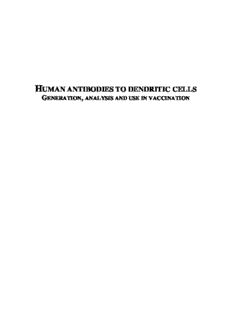
Human Antibodies to Dendritic Cells Generation: Analysis and Use in Vaccination PDF
Preview Human Antibodies to Dendritic Cells Generation: Analysis and Use in Vaccination
H UMAN ANTIBODIES TO DENDRITIC CELLS GENERATION, ANALYSIS AND USE IN VACCINATION H UMAN ANTIBODIES TO DENDRITIC CELLS GENERATION, ANALYSIS AND USE IN VACCINATION HUMANE ANTILICHAMEN TEGEN DENDRITISCHE CELLEN Ontwikkeling, analyse en gebruik in vaccinatie (met een samenvatting in het Nederlands) PROEFSCHRIFT ter verkrijging van de graad van doctor aan de Universiteit Utrecht op gezag van de Rector Magnificus, Prof. dr. W.H. Gispen, ingevolge het besluit van het College voor Promoties in het openbaar te verdedigen op vrijdag 31 mei 2002 des middags te 2.30 uur door Annemarie Nicolette Lekkerkerker geboren op 6 december 1972, te Asse, België Promotoren Prof. dr. T. Logtenberg Prof. dr. H. Clevers Cover: ‘Black Hollyhock with Blue Larkspur’ Georgia O’Keeffe 1929 ISBN: 90-393-3038-7 The studies described in this thesis were performed at the Department of Immunology, University Medical Center Utrecht, The Netherlands and were financially supported by Crucell N.V.. When you take a flower in your hand and really look at it, it’s your world for the moment. Georgia O’Keeffe CONTENTS CHAPTER 1 General introduction 9 CHAPTER 2A Phage antibodies against human dendritic cell subpopulations by 33 flow-cytometry based selection on freshly isolated cells CHAPTER 2B Phage antibodies selected on dendritic cells in human tonsil 51 CHAPTER 3 Reactivity profiles of human IgG4 monoclonal antibodies on naturally 69 occurring and cultured dendritic cell subsets CHAPTER 4 Binding and crosslinking of huMab MatDC 64 prevents the in vitro 97 differentiation of human monocytes into dendritic cells CHAPTER 5 In vitro antibody-mediated delivery of melanoma tumor antigen MAGE-1 111 to immature dendritic cells results in anti-tumor T and CTL responses H CHAPTER 6 Lipid-tagged scFv fragments incorporated in tumor cells mediate 131 receptor-dependent targeting to antigen presenting cells CHAPTER 7 Summarizing discussion 145 Nederlandse Samenvatting 155 Curriculum Vitae 157 List of Publications 158 Nawoord 159 CHAPTER 1 G ENERAL INTRODUCTION GENERAL INTRODUCTION INTRODUCTION The life cycle of dendritic cells Dendritic cells (DCs), first described in 1973 by Steinman and Cohn 1, are now widely recognized as professional antigen presenting cells (APCs) that play a pivotal role in directing the immune response. The ability of DCs to process and present a broad variety of antigens, to which an organism is exposed, is unmatched. The functioning of the immune system is based on two distinct types of responses, the innate and the adaptive immune response. The innate immune response, mediated by a variety of cell types including natural killer (NK) cells and macrophages, forms the first line of defense towards infections and is regarded as non-specific. The adaptive immune response depends on the activity of antigen-specific effector T and B cells and is notable for its exquisite specificity for the inciting antigen and the generation of memory for antigens. DCs are innate immune cells and acutely activated when a pathogen invades the body, but they also play a decisive and instructive role in the adaptive immune response that arises 2. Given that the induction of productive T cell responses depends upon activation of DCs, it follows that the DC serves as a pivotal interface bridging the innate and adaptive immune system. Generated in large numbers in the bone marrow every day, precursor DCs circulate in the blood stream and migrate into tissues, where they reside as sentinels in an immature state, the prototype being Langerhans cells in the epidermis. Immature DCs have a high phagocytic and endocytic capacity and constantly sample their environment for antigens at potential sites of pathogen entry. Upon encounter of an antigen and the exposure to ‘danger’ signals (pathogens, tissue damage and local inflammation) immature DCs migrate to the lymphoid organs (Fig. 1). During this migration, which is regulated by altered expression of chemokine receptors, DCs undergo the maturation process that is characterized by down-regulation of the capacity to capture antigen and up-regulation of antigen processing and presentation, and of expression of co-stimulatory molecules. In the secondary lymphoid organs, mature DCs present antigens captured in the periphery to resting or naive T cells, inducing an adaptive immune response. After delivery of their pathogen-related information, the DCs, no longer necessary for the acute response to antigen, presumably undergo apoptotic cell death and are eliminated. 11
